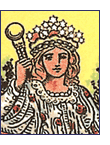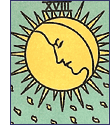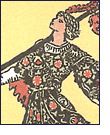|
The exact history and origins of the tarot
deck vary widely from continent to continent and from one theologist
to another. Common theories therefore are ones which can only be
referred to as possible clues to the exact origin although like
the mystical deck of cards they are open to interpretation and far
closer examination.
 Earliest
theories tell of the migration of nomadic gypsies from Egypt and
India toward the west. Knowing the western world had a deep fascination
for all things magical and mysterious a route was plotted to escape
persecution and embark on more fertile lands around the ninth century.
They brought to Europe a new and widely differing culture and heritage
to that seen in the Christian dominated continent. The tarot cards
were in fact a diminutive form of the bible of occult beliefs, which
could be easily transported in card format and easily disguised
as a visual imagery, which under scrutiny could be passed off as
Far Eastern gaming cards. Earliest
theories tell of the migration of nomadic gypsies from Egypt and
India toward the west. Knowing the western world had a deep fascination
for all things magical and mysterious a route was plotted to escape
persecution and embark on more fertile lands around the ninth century.
They brought to Europe a new and widely differing culture and heritage
to that seen in the Christian dominated continent. The tarot cards
were in fact a diminutive form of the bible of occult beliefs, which
could be easily transported in card format and easily disguised
as a visual imagery, which under scrutiny could be passed off as
Far Eastern gaming cards.
These nomads were aware of the fascination they brought and the
mystical occult bible they carried served as a tool with which they
could exercise their mystical arts to the west. Fortune telling
then became the principle use of the cards and continued to act
as a covert disguise for the religious meanings they carried.
 The
ability to disguise true meaning and intent was inherent in the
history of the tarot especially centuries later during the periods
of intense persecution in the middle ages. During periods of acute
oppression during the twelfth to the fourteen centuries images were
open to interpretation and not as finite as the written word. This
being the case religious orders and occult beliefs could shelter
in safe harbor until attitudes changed. Indeed it was the fact that
interpretation was so individual which led to the rapid increase
in the popularity of the cards universally across the social spectrum.
The illiterate as well as the noble could undertake the task of
interpreting the mystical images and ancient mythical forms presented
in the tarot cards. The
ability to disguise true meaning and intent was inherent in the
history of the tarot especially centuries later during the periods
of intense persecution in the middle ages. During periods of acute
oppression during the twelfth to the fourteen centuries images were
open to interpretation and not as finite as the written word. This
being the case religious orders and occult beliefs could shelter
in safe harbor until attitudes changed. Indeed it was the fact that
interpretation was so individual which led to the rapid increase
in the popularity of the cards universally across the social spectrum.
The illiterate as well as the noble could undertake the task of
interpreting the mystical images and ancient mythical forms presented
in the tarot cards.
It was however renaissance Italy during the fifteenth century that
brought this covert belief to the fore and shaped the way tarot
cards are perceived and looked upon today. Creatively the northern
city-states of Florence and Venice were operating at a level unseen
elsewhere in the world at the time. Liberal thinking flourished
and culturally the hub of the western world welcomed the rediscovered
beauty not only of the artwork of the tarot cards but the mystical
beliefs, which were woven around them.
 Post
medieval tyranny had led to a state where liberal thinking and suggestion
were positively encouraged and nurtured. The great time of religious
persecution was deemed to be over. Libraries from monastic orders
were opened up revealing secrets kept from the world for centuries
pertaining to the mystical and ancient past of mankind. Egyptian
manuscripts and imagery were suddenly en vogue and a new approach
to man, mind the world and power bases were embarked upon. Post
medieval tyranny had led to a state where liberal thinking and suggestion
were positively encouraged and nurtured. The great time of religious
persecution was deemed to be over. Libraries from monastic orders
were opened up revealing secrets kept from the world for centuries
pertaining to the mystical and ancient past of mankind. Egyptian
manuscripts and imagery were suddenly en vogue and a new approach
to man, mind the world and power bases were embarked upon.
Commissioned works of art were abounding with mystical and religious
meaning and it can be stated that fascination with astrological
symbolism was as great during this period as it is today. Dreams
and aspirations could be played out through the cards where ideas
could be derived from that which was desired rather than in centuries
previous from that which was enforced.
Beautifully gold encrusted works of art appeared for use as a means
of interpreting and meditation. Tarot was shaping itself in to the
present form commonly known today. The advice given by the cards
was open to interpretation but also open to subsequent action. Some
chose to head the advice given some chose to ignore. The important
thing being that a choice was freely available. The decks varied
from century to century and from one interpretation to the next
but now with innumerable number of tarot cards open to use the astrological,
mystical and ancient art has flourished for the past five centuries
and will undoubtedly continue do so well into the future.
|





